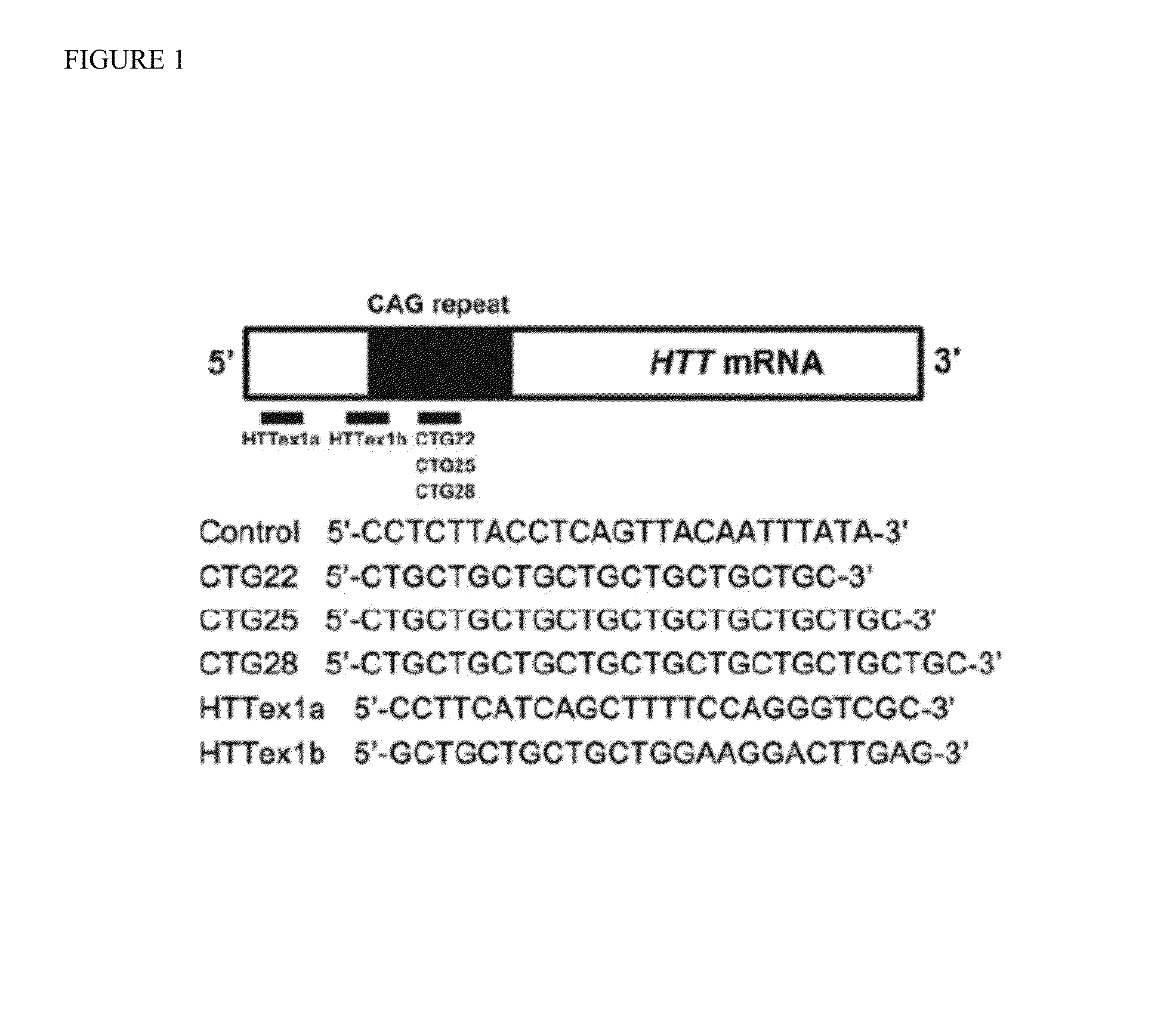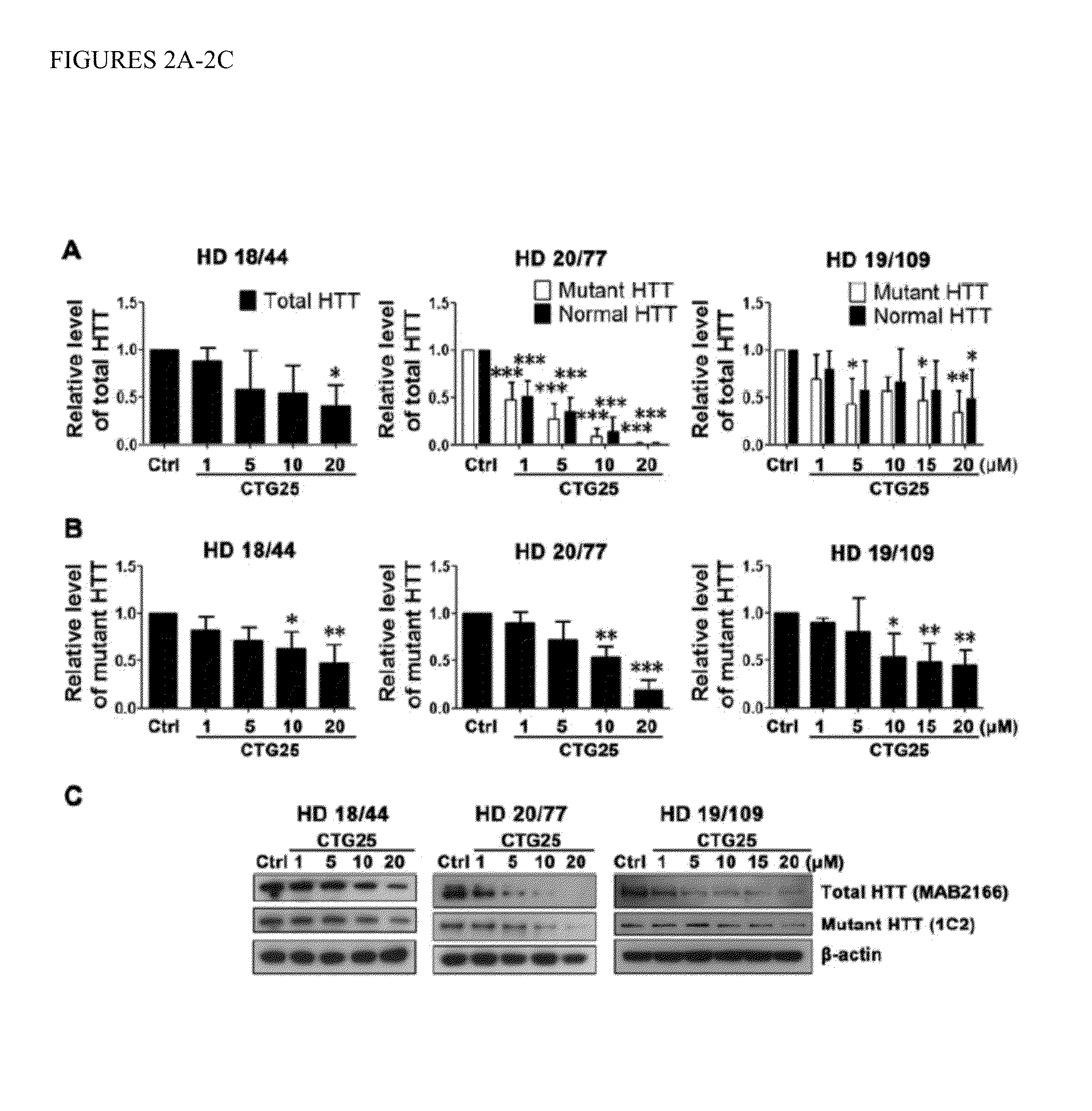Phosphorodiamidate morpholino oligomers (PMOS) and their use in suppression of mutant huntingtin expression and attenuation of neurotoxicity
a phosphorodiamidate morpholino oligomer and mutant huntingtin technology, which is applied in the field of phosphorodiamidate morpholino oligomers (pmos) and their use in suppressing mutant huntingtin expression and attenuating neurotoxicity, can solve the problems of mutant htt rna itself being toxic, affecting the stability of sirna, and affecting the effect of pmos, so as to reduce htt protein
- Summary
- Abstract
- Description
- Claims
- Application Information
AI Technical Summary
Benefits of technology
Problems solved by technology
Method used
Image
Examples
example 1
[0093]The specificity and effectiveness of a PMO depend on its sequence and concentration, as well as on the length of the targeted CAG repeat.
[0094]Based on the use of PMOs to ameliorate the toxicity of the CUG repeat expansion within the DMPK transcript associated with myotonic dystrophy 1 (DM1), we synthesized three CAG repeat-targeting PMOs, CTG22, CTG25 and CTG28, respectively (FIG. 1). The optimal length for a PMO is about 25 bases and the longest PMO that could be synthesized was 30 bases. The high transfection efficiency of approximately 90% was confirmed by delivering fluorescein isothiocyanate (FITC)-labeled standard control (Ctrl) PMO into multiple cell lines (FIG. 11) and visualizing FITC distribution through an eGFP filter. We evaluated PMO specificity and effectiveness in reducing mutant HTT protein levels in three HD patient-derived fibroblast cell lines, HD 18 / 44, HD 20 / 77 and HD 19 / 109 (Table 1; numbers indicate CAG repeat sizes within normal and mutant HTT alleles)...
example 2
[0097]The off-target effect of CAG repeat-targeting PMOs depends on PMO sequence and concentration.
[0098]Off-target effect is an important criterion in evaluating the therapeutic potential of repeat-targeting ASO approaches. Besides HTT, there are at least 40 human genes with seven or more consecutive CAG triplets. To assess the off-target effect of repeat-targeting PMOs in this study, we chose five control genes that normally contain long CAG repeats: ataxin-2 (ATXN2), ataxin-3 (ATXN3), TATA box binding protein (TBP), androgen receptor (AR) and retinoic acid induced 1 (RAII). The repeat sizes of ATXN2, ATXN3 and TBP in three HD cell lines examined are shown in Table 1. Treatment with CTG22 significantly reduced the levels of endogenous ATXN3 in both HD 20 / 77 and HD 19 / 109 fibroblasts (FIG. 5B). Reduction of endogenous ATXN2 by PMO CTG22 in cell line HD 20 / 77 was not statistically significant (FIG. 5A). A high concentration of PMO CTG25 also inhibited endogenous ATXN3 expression to ...
example 3
[0100]Non-CAG repeat-targeting PMOs reduce HTT levels with high target selectivity.
[0101]In addition to targeting the CAG repeat region in HTT RNA, targeting other regions can be a feasible therapeutic approach if levels of normal HTT remain sufficient to support normal cell function. We therefore designed two non-CAG repeat-targeting PMOs, HTTex1a and HTTex1b (FIG. 1), and examined their effectiveness in suppressing HTT expression in cell line HD 19 / 109. HTTex1a binds to the first 25 bases downstream of the start codon in HTT RNA, and HTTex1b binds to the region immediately upstream of the CAG repeat. As expected, HTTex1a and HTTex1b modestly decreased both normal and mutant HTT levels without allelic selectivity (FIGS. 6A, 6B and 6D). No effect on expression of endogenous ATXN2 or ATXN3 was detected with either of the PMOs (FIGS. 6C and 6D), as expected given the HTT specificity of these PMOs. The relatively small effect of these PMOs on HTT expression compared to repeat-targeting...
PUM
| Property | Measurement | Unit |
|---|---|---|
| length | aaaaa | aaaaa |
| composition | aaaaa | aaaaa |
| size | aaaaa | aaaaa |
Abstract
Description
Claims
Application Information
 Login to View More
Login to View More - R&D
- Intellectual Property
- Life Sciences
- Materials
- Tech Scout
- Unparalleled Data Quality
- Higher Quality Content
- 60% Fewer Hallucinations
Browse by: Latest US Patents, China's latest patents, Technical Efficacy Thesaurus, Application Domain, Technology Topic, Popular Technical Reports.
© 2025 PatSnap. All rights reserved.Legal|Privacy policy|Modern Slavery Act Transparency Statement|Sitemap|About US| Contact US: help@patsnap.com



